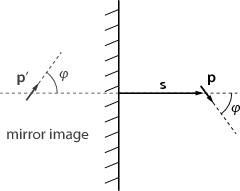
The spatial charge density can be expressed in terms of the concentration n and charge q of positive and negative ions:

For simplicity, consider the case when q+ = -q- = q, and the concentration of both kinds of ions is n0 far from the colloidal particle.

For kT ≫ qϕ the approximation ex ≈ 1 + x can be used. Thus

Substituting this into Poisson’s equation and using the spherical symmetry of the problem we get

This differential equation can be written as

whose general solution is rϕ = C1e- r + C
2e
r + C
2e r. For the potential
to be zero at infinity, it is required that C2 = 0. When r → 0, the
potential must be the same as in the absence of any ions: C1 = Q∕4πε0,
where Q is the charge of the colloidal particle.
r. For the potential
to be zero at infinity, it is required that C2 = 0. When r → 0, the
potential must be the same as in the absence of any ions: C1 = Q∕4πε0,
where Q is the charge of the colloidal particle.

|
|
Let us imagine that the sheet is removed, and another electric dipole  ′ is
added in such a way that it is the mirror image of
′ is
added in such a way that it is the mirror image of  with respect to the
plane of the sheet, but its direction is reversed (see figure 1). It is easy to
see that the electric potential created by
with respect to the
plane of the sheet, but its direction is reversed (see figure 1). It is easy to
see that the electric potential created by  and
and  ′ together is constant in the
mirror plane. We know that the solution of Laplace’s equation is unique if
the boundary conditions are fixed. Thus the field created in the
right-hand-side half-space by the charges on the conducting sheet must be
the same as the field created by a mirror dipole
′ together is constant in the
mirror plane. We know that the solution of Laplace’s equation is unique if
the boundary conditions are fixed. Thus the field created in the
right-hand-side half-space by the charges on the conducting sheet must be
the same as the field created by a mirror dipole  ′ in the absence of the
sheet. Now all we need to do is find the torque acting on
′ in the absence of the
sheet. Now all we need to do is find the torque acting on  in such a
field.
in such a
field.
The electric potential created by a dipole  ′ is
′ is

The electric field vector is

and the potential energy of a dipole  in this field is
in this field is

Let θ and θ′ denote the angles between  , and the vectors
, and the vectors  and
and  ’,
respectively. If both
’,
respectively. If both  and
and  ′ have the same magnitude, then the potential
energy can be written as
′ have the same magnitude, then the potential
energy can be written as

The magnitude of the torque acting on the dipole  is just
is just

Let us apply this result to the dipole and its mirror image. We have r = 2s and θ = θ′ = φ, so
 |
If the dipole is free to rotate, it will adopt one of the positions where the torque is 0, i.e. φ = 0, φ = π∕2, or φ = π. Of these three, φ = π∕2 is an unstable equilibrium, so the dipole will be perpendicular to the plane.

In a steady state the current density I∕A = ρ(x)v(x) between the plates is
constant. Here v(x) denotes the velocity of the electrons when they are
at distance x from the cathode. The electrons gain their kinetic
energy from the electric field, so Ekinetic = mv2∕2 = eV (x), where e
is the elementary charge. Using these two relations we find that
ρ(x) = (I∕A) ∕
∕ . Substituting this result into Poisson’s
equation,
. Substituting this result into Poisson’s
equation,

Note that C > 0 because the physical current is flowing from the anode to
the cathode: j < 0. We seek the solution of this differential equation in the
form V (x) = βxα. Substituting this back into the equation we find that
α = 4∕3 and β = (9C∕4)2∕3. This is not a general solution as it does
not contain any arbitrary constants but it satisfies the boundary
conditions of the problem: V (0) = 0 and  x=0 = 0 (the electric field is
0 at the cathode), so we need seek no further. The final results
are
x=0 = 0 (the electric field is
0 at the cathode), so we need seek no further. The final results
are



Putting x = d to find V 0, we get


